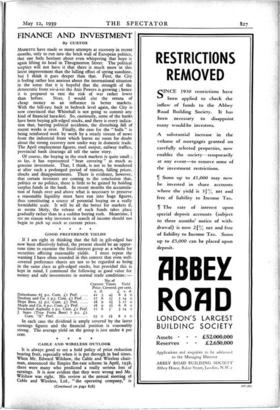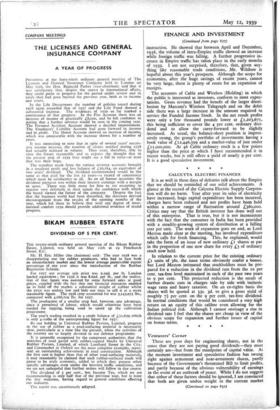CABLE AND WIRELESS OUTLOOK
It is always good to see a bold policy of price reduction bearing fruit, especially when it is put through in bad times. When Mr. Edward Wilshaw, the Cable and Wireless chair- man, announced the Empire flat-rate scheme in April, 1938, there were many who predicted a really serious loss of earnings. It is now evident that they were wrong and Mr. Wilshaw was right. His review at the annual meeting of Cable and Wireless, Ltd., " the operating company," is (Continued on page 828) FINANCE AND INVESTMENT (Continued from page 827)
instructive. He showed that between April and December, 1938, the volume of intra-Empire traffic showed an increase while foreign traffic was falling. A further progressive in- crease in Empire traffic has taken place in the early months of 1939. I am not surprised, therefore, that, given any- thing like reasonable trade conditions, Mr. Wilshaw is hopeful about this year's prospects. Although the scope for economies, after the huge savings of recent years, cannot be very large, there is plenty of room for an expansion of receipts.
The accounts of Cable and Wireless (Holding) in which the public is interested as investors, conform to most expec- tations. Gross revenue had the benefit of the larger distri- bution by Marconi's Wireless Telegraph and on the debit side there was a large increase in the amount required to service the Funded Income Stock. In the net result profits were only a few thousand pounds lower at £1,203,671, this being sufficient to cover the 4 per cent. ordinary divi- dend and to allow the carry-forward to be slightly increased. As usual, the balance-sheet position is impres- sively strong, the group's portfolio of investments having a book value of £12,446,599 and a market-value of just under LI r,000,000. At 46 Cable ordinary stock is a few points higher than the price at which I have recommended it in recent weeks, but it still offers a yield of nearly 9 per cent. It is a good speculative investment.



















































 Previous page
Previous page